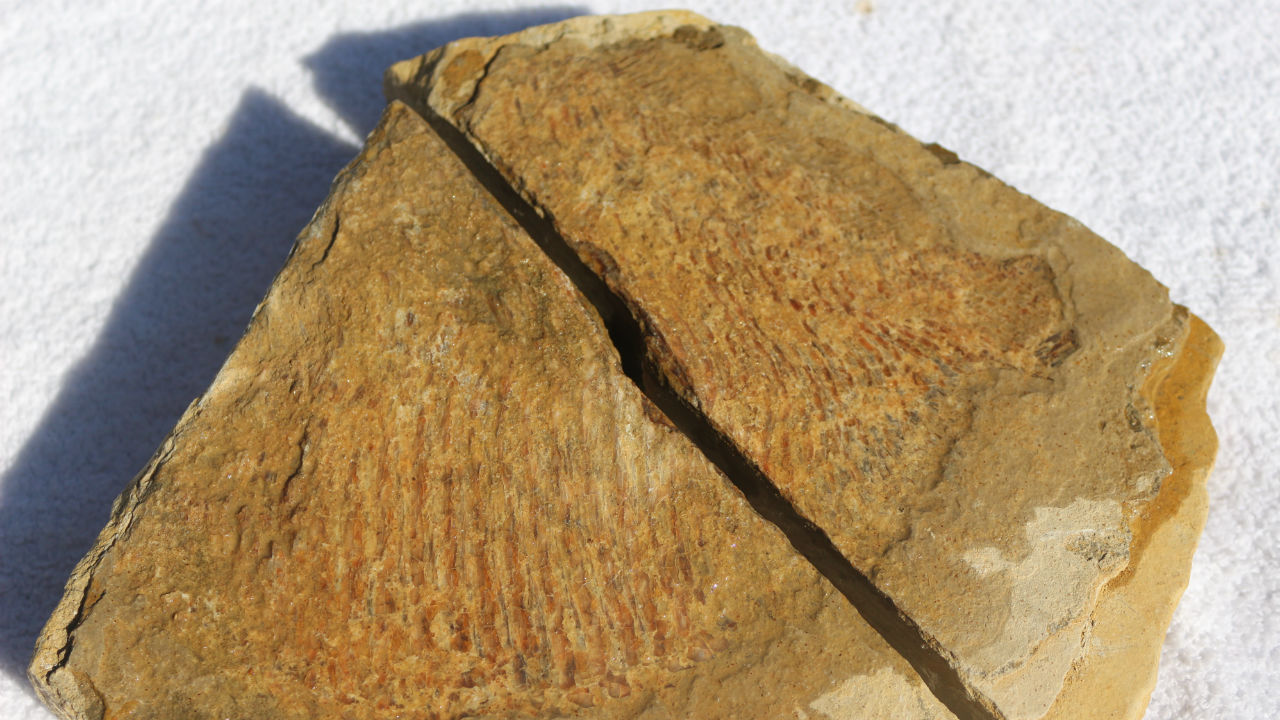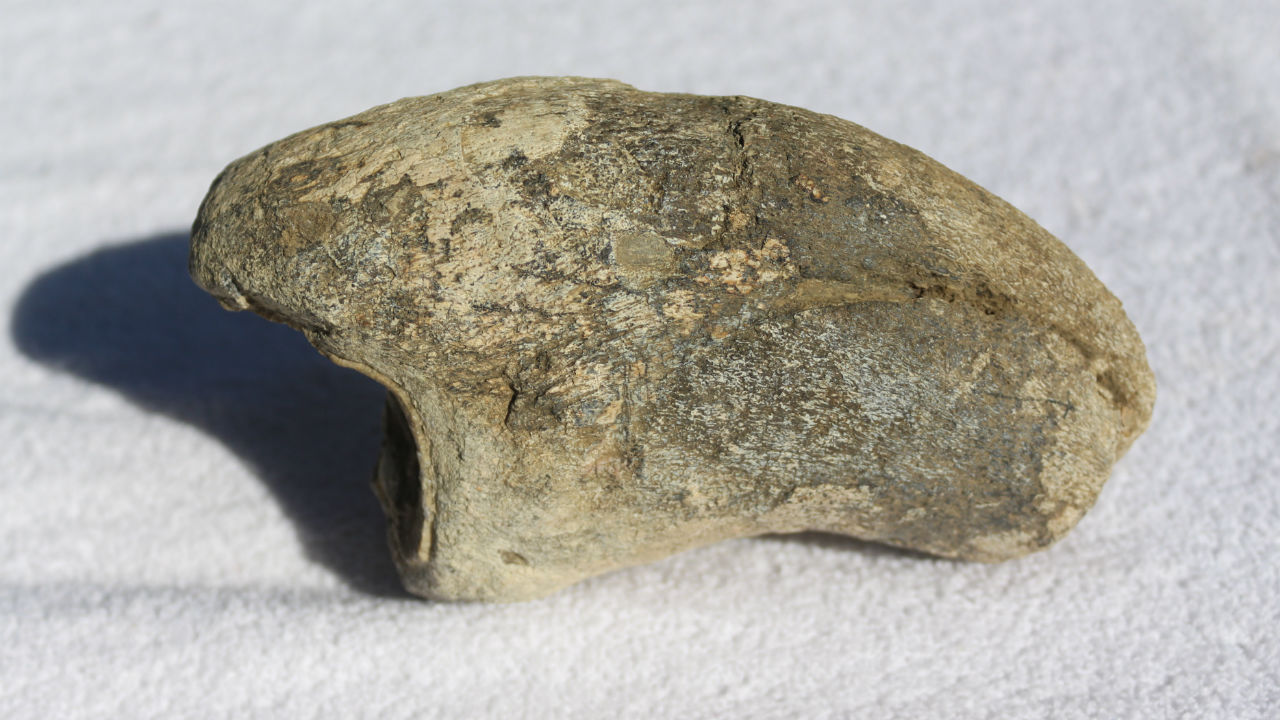The area is located in the basin of Godavari and Pranhita rivers, and could be the only site in India where both faunal and floral fossil remains are found
In a major discovery, a team of domestic and international experts has unearthed around 70 Jurrasic-era fossils from Sironcha in Gadchiroli district. The area, which forms part of the upper Gondwana Kota formations, is located in the basin of the Godavari and Pranhita rivers, and is perhaps the only site in India where both, faunal and floral fossil remains are found.

The fossils discovered on Wednesday are estimated to be around 150 to 160 million years old.
“We recovered around 70 dinosaur fossil bones including rib and neck parts, vertebrae, toe piece and a fish fossil,” said Tushar Chavan, deputy conservator of forests, Sironcha.

Dhananjay Mohabe, retired deputy director general, Geological Survey of India (GSI), said the finds indicated that apart from Jurrasic-era Kotasaurus and Barapasaurus dinosaurs, there was possibly a third new type of sauropod dinosaur in the habitat during this period. Mohabe was part of the team with Jeffrey Wilson from the University of Michigan and Gregory Wilson, University of Washington.
Incidentally, the only two complete dinosaur skeletons mounted for display in India were recovered from the Pranhita- Godavari valley landscape, noted Mohabe. This includes a Sauropod (Barapasaurus tagorei) skeleton from the Pochampalli village (1959) which is displayed at the Indian Statistical Institute, Kolkata. Another sauropod (Kotasaurus yamanpalliensis) was unearthed at nearby Yamanpalli in Telangana in the 1990s and is at Birla Science Museum in Hyderabad.
The landscape has exposed Jurassic-era fossil remains including flora (tree logs and leaves) and fauna (reptiles including Kotasaurus and Barapasaurus dinosaur and fishes).
D.K Kapgate, retired professor of paleobotany, who was part of the team, said scientific excavations may reveal more intact skeletons. Kapgate said unlike other Indian sites with Jurrasic-era remains like Anjar in Gujarat (dinosaur fossils) and Mandla in Madhya Pradesh (plant fossils), the Sironcha site was diverse with a variety of fossils, namely wood, mammals, reptile, fish, crocodiles and plants.
Nusrat Babar Shaikh from the C.V Raman science college at Sironcha, who has conducted research on these fossils, said the discoveries would help scientists understand the Jurrasic-era habitat and climate in the region.
“Though plant fossils have been found in the Nagpur- Chhindwara belt, they are from an uppermost cretaceous period, namely 40 to 60 million years, compared to these recoveries from the Jurrasic-era,” Kapgate explained.
The Maharashtra forest department is developing the ‘Wadadham Fossil Wood Park’ at Sironcha with replicas of dinosaurs and exhibits of their bones and plant fossils. It is located at a distance of around 400km from Nagpur.
![submenu-img]() This Indian company is world's strongest brand, it's not Reliance, TCS, Wipro, Infosys or Adani Group
This Indian company is world's strongest brand, it's not Reliance, TCS, Wipro, Infosys or Adani Group![submenu-img]() This Mughal emperor was called 'Zinda Peer' because...
This Mughal emperor was called 'Zinda Peer' because...![submenu-img]() Dinesh Karthik names Rohit Sharma's opening partner for Champions Trophy 2025, it's not Yashasvi Jaiswal
Dinesh Karthik names Rohit Sharma's opening partner for Champions Trophy 2025, it's not Yashasvi Jaiswal![submenu-img]() ‘National Space Day, 2024’: Tribute to India’s Stellar Footprints and Catalyst for Future Exploration
‘National Space Day, 2024’: Tribute to India’s Stellar Footprints and Catalyst for Future Exploration![submenu-img]() Badlapur sexual assault case: Internet suspended, 72 arrested amid massive protest
Badlapur sexual assault case: Internet suspended, 72 arrested amid massive protest ![submenu-img]() Jammu-Kashmir Assembly Elections: कांग्रेस और नेशनल कॉन्फ्रेंस का गठबंधन तय, फारूक अब्दुल्ला बोले- मिलकर लेंगे राज्य का दर्जा वापस
Jammu-Kashmir Assembly Elections: कांग्रेस और नेशनल कॉन्फ्रेंस का गठबंधन तय, फारूक अब्दुल्ला बोले- मिलकर लेंगे राज्य का दर्जा वापस![submenu-img]() लेह में बड़ा हादसा, 200 मीटर गहरी खाई में गिरी बस, 6 की मौत और 22 से ज्यादा घायल
लेह में बड़ा हादसा, 200 मीटर गहरी खाई में गिरी बस, 6 की मौत और 22 से ज्यादा घायल![submenu-img]() Ayodhya Rape Case : आरोपी मोईद खान के खिलाफ बुलडोजर एक्शन , Video में देखें सपा नेता का शॉपिंग कॉम्प्लेक्स हुआ तहस-नहस
Ayodhya Rape Case : आरोपी मोईद खान के खिलाफ बुलडोजर एक्शन , Video में देखें सपा नेता का शॉपिंग कॉम्प्लेक्स हुआ तहस-नहस![submenu-img]() Shri Krishna Mantra: कृष्ण जन्माष्टमी पर इन मंत्रों का करेंगे जाप तो दूर हो जाएंगे सभी कष्ट, मनोकामना पूर्ण करेंगे भगवान
Shri Krishna Mantra: कृष्ण जन्माष्टमी पर इन मंत्रों का करेंगे जाप तो दूर हो जाएंगे सभी कष्ट, मनोकामना पूर्ण करेंगे भगवान![submenu-img]() 'आप मोहरे चल रहे थे, मैं रिश्तेदारी नि��भा रहा था' RJD महासचिव श्याम रजक ने भेजा लालू को इस्तीफा
'आप मोहरे चल रहे थे, मैं रिश्तेदारी नि��भा रहा था' RJD महासचिव श्याम रजक ने भेजा लालू को इस्तीफा![submenu-img]() Meet taxi driver's son, who was humiliated by police, cracked UPSC exam, then become...
Meet taxi driver's son, who was humiliated by police, cracked UPSC exam, then become...![submenu-img]() Meet Indian boy who became world’s youngest surgeon at 7, studied at IIT, he is now...
Meet Indian boy who became world’s youngest surgeon at 7, studied at IIT, he is now...![submenu-img]() Meet woman who lost her father at young age battled society's doubts, then transformed a cinema hall into...
Meet woman who lost her father at young age battled society's doubts, then transformed a cinema hall into...![submenu-img]() Meet man, who left high-paying job to crack UPSC exam, first become IPS, then IAS with AIR...
Meet man, who left high-paying job to crack UPSC exam, first become IPS, then IAS with AIR...![submenu-img]() 5 high-paying jobs in India without a college degree, check here
5 high-paying jobs in India without a college degree, check here![submenu-img]() Kolkata Doctor Murder: BJP Asks CM Mamata Banerjee To Resign Over Kolkata Murder-Rape Case
Kolkata Doctor Murder: BJP Asks CM Mamata Banerjee To Resign Over Kolkata Murder-Rape Case![submenu-img]() Kolkata Doctor Murder: Chirag Paswan Questions CM Mamata’s Protest Rally Over Kolkata Doctor Murder
Kolkata Doctor Murder: Chirag Paswan Questions CM Mamata’s Protest Rally Over Kolkata Doctor Murder![submenu-img]() Kolkata Doctor Murder: Kolkata Doctor's Autopsy Reveals Details Of Injuries And Sexual Assault
Kolkata Doctor Murder: Kolkata Doctor's Autopsy Reveals Details Of Injuries And Sexual Assault![submenu-img]() Kolkata Doctor Murder: WB Governor Slams CM Mamata, Says Not Society But Present Govt. Failed Women
Kolkata Doctor Murder: WB Governor Slams CM Mamata, Says Not Society But Present Govt. Failed Women![submenu-img]() Uttarakhand Bus Stand Rape: Five Held After Girl Gang-Raped In A Bus At Dehradun ISBT
Uttarakhand Bus Stand Rape: Five Held After Girl Gang-Raped In A Bus At Dehradun ISBT![submenu-img]() Where is Olympics Gold medalist Arshad Nadeem? Will he challenge Neeraj Chopra at Diamond League?
Where is Olympics Gold medalist Arshad Nadeem? Will he challenge Neeraj Chopra at Diamond League?![submenu-img]() Vinesh Phogat to enter politics? Report says she is likely to contest against...
Vinesh Phogat to enter politics? Report says she is likely to contest against...![submenu-img]() Arshad Nadeem's net worth was just Rs 80 lakh before Gold medal win, his current net worth is Rs...
Arshad Nadeem's net worth was just Rs 80 lakh before Gold medal win, his current net worth is Rs...![submenu-img]() Haryana govt awards Rs 5 crore to Olympics medallist Manu Bhaker, check how much Neeraj Chopra, Vinesh Phogat got
Haryana govt awards Rs 5 crore to Olympics medallist Manu Bhaker, check how much Neeraj Chopra, Vinesh Phogat got![submenu-img]() Vinesh Phogat finally smiles again as she receives gold medal after Paris Olympics heartbreak
Vinesh Phogat finally smiles again as she receives gold medal after Paris Olympics heartbreak![submenu-img]() Eat these healthy vegan foods if you want to lose weight
Eat these healthy vegan foods if you want to lose weight![submenu-img]() In: 5 beautiful places you must visit in Kalka-Shimla
In: 5 beautiful places you must visit in Kalka-Shimla![submenu-img]() Meet Salman Khan's 'niece' who worked in TV, became star at 7, was called 'mini Katrina Kaif'; then left films, now...
Meet Salman Khan's 'niece' who worked in TV, became star at 7, was called 'mini Katrina Kaif'; then left films, now...![submenu-img]() Countries with highest number of vegetarians
Countries with highest number of vegetarians![submenu-img]() This Amitabh flop was rejected by Dilip Kumar, had 4 stars, its failure was celebrated by film industry, earned only..
This Amitabh flop was rejected by Dilip Kumar, had 4 stars, its failure was celebrated by film industry, earned only..![submenu-img]() ‘National Space Day, 2024’: Tribute to India’s Stellar Footprints and Catalyst for Future Exploration
‘National Space Day, 2024’: Tribute to India’s Stellar Footprints and Catalyst for Future Exploration![submenu-img]() Badlapur sexual assault case: Internet suspended, 72 arrested amid massive protest
Badlapur sexual assault case: Internet suspended, 72 arrested amid massive protest ![submenu-img]() What Sebi can learn from Pinochet case in conflict and propriety
What Sebi can learn from Pinochet case in conflict and propriety![submenu-img]() Raipur-Hyderabad Expressway: Check travel time, distance, route, status and more
Raipur-Hyderabad Expressway: Check travel time, distance, route, status and more![submenu-img]() PM Modi arrives in Poland, first visit by Indian PM in 45 years
PM Modi arrives in Poland, first visit by Indian PM in 45 years![submenu-img]() Jammu and Kashmir Assembly elections: What is delimitation that paved the road for these Elections?
Jammu and Kashmir Assembly elections: What is delimitation that paved the road for these Elections?![submenu-img]() Wings of Refuge: Rafales escort Hasina to safety
Wings of Refuge: Rafales escort Hasina to safety![submenu-img]() Bangladesh in a crisis: A coup, protests and a fleeing Prime Minister
Bangladesh in a crisis: A coup, protests and a fleeing Prime Minister![submenu-img]() DNA Explainer: What is Waqf Board Act and why does Modi government want to amend it?
DNA Explainer: What is Waqf Board Act and why does Modi government want to amend it?![submenu-img]() DNA Explainer: Why is Bangladesh burning again?
DNA Explainer: Why is Bangladesh burning again?












































)
)
)
)
)
)
)
)
)
)
)
)
)
)
)







)
)
)
)
)
)